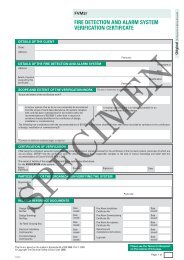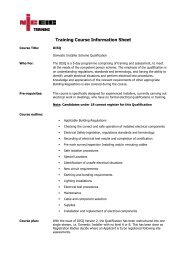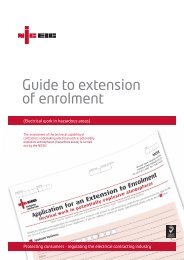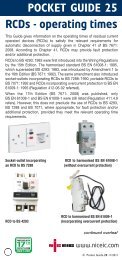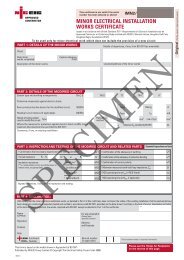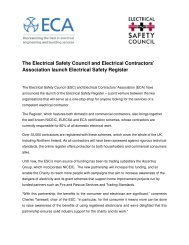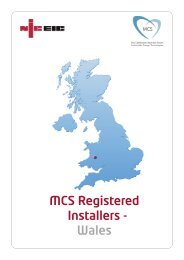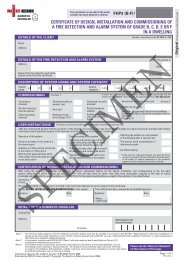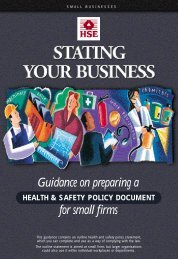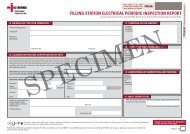Pocket guide 17: PIR Recommendation Codes - NICEIC
Pocket guide 17: PIR Recommendation Codes - NICEIC
Pocket guide 17: PIR Recommendation Codes - NICEIC
- No tags were found...
Create successful ePaper yourself
Turn your PDF publications into a flip-book with our unique Google optimized e-Paper software.
POCKET GUIDE <strong>17</strong><strong>PIR</strong> <strong>Recommendation</strong> <strong>Codes</strong>This <strong>guide</strong> gives basic information about Periodic Inspection Report (<strong>PIR</strong>)<strong>Recommendation</strong> <strong>Codes</strong>. It is based on information given in the Electrical SafetyCouncil’s Best Practice Guide 4 – Periodic inspection reporting –recommendation codes for domestic and similar electrical installations, which isavailable as a free download from www.esc.org.ukThe aim of Best Practice Guide 4, and this pocket <strong>guide</strong>,is to provide guidance on the use of <strong>Recommendation</strong><strong>Codes</strong> for competent persons (as defined in Best PracticeGuide 4) producing <strong>PIR</strong>s.Best Practice Guide 4, and this pocket <strong>guide</strong>, are limitedto the range of observations associated with domesticand similar electrical installations, and take into accountthe requirements of BS 7671: 2008.Each observation entered by the competent person in the <strong>PIR</strong> must be given anappropriate <strong>Recommendation</strong> Code 1, 2, 3 or 4. This is for the benefit of theperson ordering the report, and of persons subsequently involved in additionalor remedial work, or further inspections. Each <strong>Recommendation</strong> Code has aparticular meaning as shown in Table 1.Table 1Description and meaning of <strong>Recommendation</strong> <strong>Codes</strong>Code Description Meaning1 Requires urgent attention This part of the installation has animmediate danger to the occupieror user and should be rectified ormade safe without delay.2 Requires improvement This part of the installation has apotential danger to the occupier oruser, which should be rectified assoon as possible.3 Requires further The condition of this part of theinvestigationinstallation cannot be determinedwithout a more in-depthinspection, which could reveal thata <strong>Recommendation</strong> Code 1 or 2 isapplicable.4 Does not comply with thecurrent edition of BS 7671 asamended. This does not implythat the electrical installation isunsafe.This part of the installationcomplies with a previous editionof the Wiring Regulations and noremedial action is recommendedin this report.Where a real and immediate danger is observed that puts the safety of thoseusing the installation at risk, a <strong>Recommendation</strong> Code 1 must be given, and thatdanger should be removed without delay.www.niceicgroup.com© <strong>Pocket</strong> Guide <strong>17</strong> 09/09
POCKET GUIDE <strong>17</strong><strong>PIR</strong> <strong>Recommendation</strong> <strong>Codes</strong>If more than one <strong>Recommendation</strong> Code could be applied to an observation, onlythe most serious one should be applied (Code 1 being the most serious).It would not be reasonable for the competent person to indicate inthe summary of a <strong>PIR</strong> that the installation is ‘satisfactory’ if anyobservation is given a Code 1 or Code 2 recommendation.Examples of the use of <strong>Recommendation</strong> <strong>Codes</strong> are shown in Table 2. However, it isthe competent person carrying out the inspection and testing who needs to decide onthe <strong>Recommendation</strong> Code to be entered against each observation in the report. Theperson(s) signing the report is fully responsible for its content and accuracy.Table 2Examples of <strong>Recommendation</strong> <strong>Codes</strong> applied to observationsCodeObservation1 a) Exposed live parts that are accessible to touch, such as where liveconductors have no (or damaged) insulation.b) Incorrect polarity, or protective device in neutral conductor only.c) Absence of RCD protection for socket-outlets in bathrooms orshower rooms, other than SELV or shaver socket-outlets.2a) A 30/32 A ring final circuit discontinuous or cross-connected withanother circuit.b) Separate protective devices in line and neutral conductors (forexample, double-pole fusing).c) A metallic pipe for gases or flammable liquids, or the metallic pipeof a water utility supply, being used as the means of earthing.3 a) Unable to trace final circuits.b) Unable to access equipment or connections needing to beinspected that are known to exist but have been boxed in such asby panels or boards that cannot be easily removed withoutcausing damage to decorations.c) Insulation resistance of less than 1 Megohm between liveconductors connected together and Earth, when measured at theconsumers unit with all final circuits connected.4 a) Absence of ‘Safety Electrical Connection – Do Not Remove’notice.b) Absence of a notice indicating that the installation has wiringcolours to two versions of BS 7671.c) Absence of RCD periodic test notice.Note: The examples listed in Table 2 are not exhaustive. Best Practice Guide 4 givesfurther examples.Certain observations may be noted on the <strong>PIR</strong>, but should not be given a<strong>Recommendation</strong> Code, such as the absence of a fire detection and alarm system.Observations that are not departures from BS 7671, such as use of BS 3871 circuitbreakers, do not need to be noted on the report.www.niceicgroup.comBased on information as at October 2008For further copies of this <strong>guide</strong>telephone 0870 0130382 or e-mail customerservice@niceic.com© <strong>Pocket</strong> Guide <strong>17</strong> 09/09



